MANAGEMENT STUDEIS Information Technology for Managers 22MBA302 Dr. Vikrama D K Assistant Professor JNNCE-MBA Shimoga 9449174652
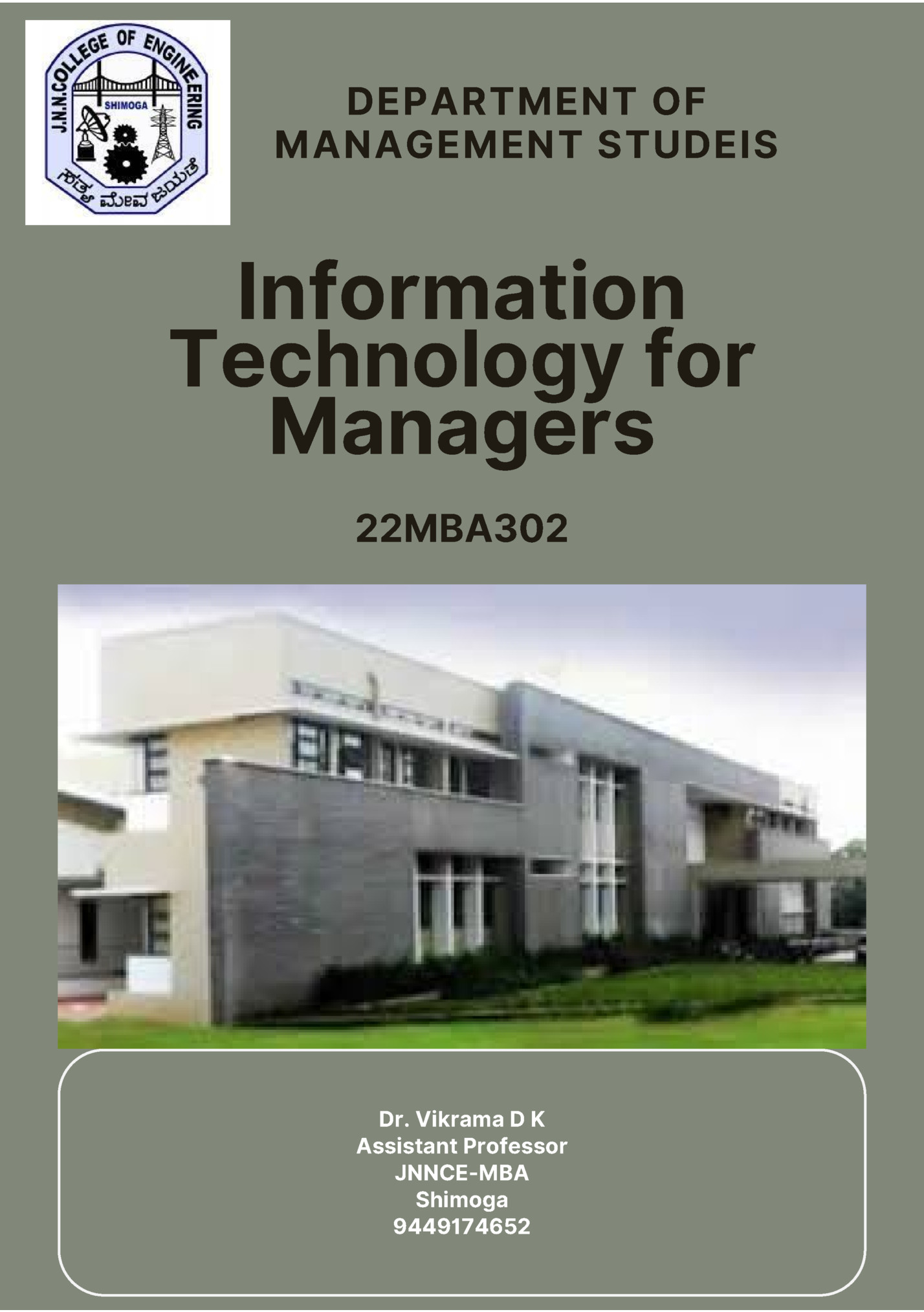
CONTENT PAGE NO. MODULE -1 1.1 INTRODUCTION TO MANAGEMENT INFORMATION SYSTEM (MIS) 3 1.2 CONCEPTS OF MANAGEMENT INFORMATION SYSTEM (MIS) 5 1.3 ROLES OF MANAGEMENT INFORMATION SYSTEM (MIS) 6 1.4 IMPACTS OF MANAGEMENT INFORMATION SYSTEM (MIS) 7 1.5 MANAGEMENT INFORMATION SYSTEM (MIS) & ITS USERS 9 1.6 COMPONENTS OF AN IS 11 1.7 MANAGEMENT AS CONTROL SYSTEMS 13 1.8 MANAGEMENT INFORMATION SYSTEM (MIS) SUPPORT TO 16 ORGANIZATION EFFECTIVENES 1.9 MANAGEMENT INFORMATION SYSTEM (MIS) FOR E- BUSINES 17 1.10 DIGITAL FIRMS 18 1.11 E-COMMERCE 21 1.12 E – COMMUNICATION 21 1.13 E-COLLABORATIONS 21 1.14 REAL TIME ENTERPRISE 22 1.15 MANAGEMENT INFORMATION SYSTEM (MIS): STRATEGIC BUSINESS 23 PLANNING 1.16 CONCEPT OF CORPORATE PLANNING 24 1.17 BALANCE SCORE CARD 25 1.18 SECURITY CHALLENGES IN E- ENTERPRISES 25 1.19 IMPACTS OF INFORMATION TECHNOLOGY ON SOCIETY 29 MODULE -2 2.1 INFORMATION SYSTEM 31 2.2 OTHER CATEGORIES OF INFORMATION SYSTEMS 32 2.3 TRANSACTION PROCESSING SYSTEM 33 2.4 DIFFERENCE BETWEEN BATCH AND REAL TIME PROCESSING 35 2.5 OFFICE AUTOMATION SYSTEMS (OAS) 35
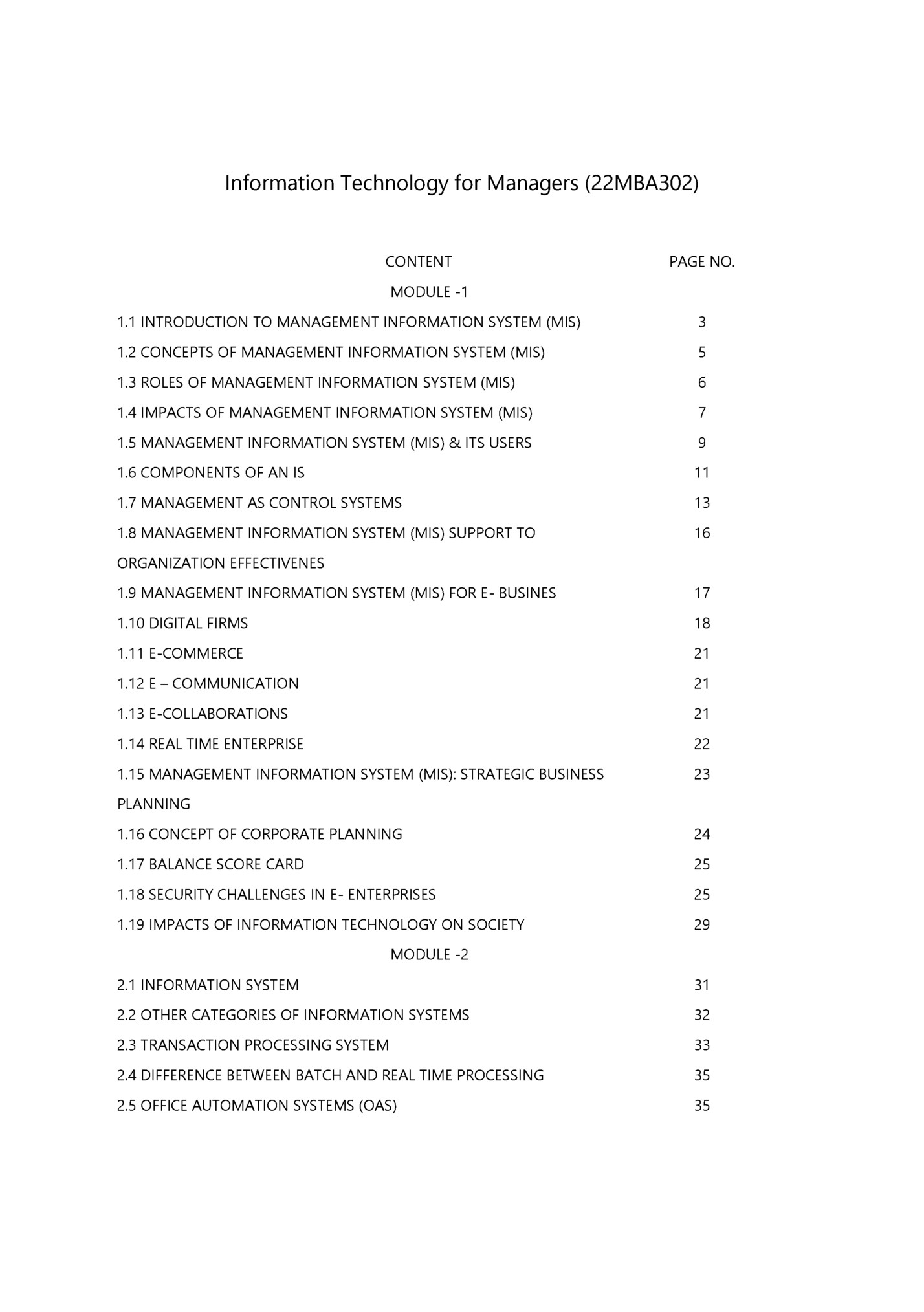
37 2.7 MANAGEMENT INFORMATION SYSTEM (MIS) 38 2.8 DECISION SUPPORT SYSTEM (DSS) 40 2.9 GROUP DECISION SUPPORT SYSTEM (GDSS) 43 2.10 KNOWLEDGE MANAGEMENT SYSTEMS 44 2.11 EXECUTIVE SUPPORT SYSTEM (EIS OR ESS) 45 2.12 STRATEGIC INFORMATION SYSTEMS 46 2.13 ETHICAL ISSUES IN INFORMATION SYSTEMS. 46 MODULE -3 3.1 SYSTEM 50 3.2 PARTS OF A SYSTEM 50 3.3 SYSTEMS CONTROL 51 3.4 SYSTEM ANALYSIS AND DESIGN 55 3.5 SYSTEM ANALYSIS 55 3.6 SYSTEM DESIGN 56 3.7 NEED FOR SYSTEM ANALYSIS 56 3.8 SYSTEM OBJECTIVE 56 3.9 STEPS IN SYSTEM ANALYSIS AND DESIGN 58 MODULE -4 4.1 APPLICATION OF MIS IN MANUFACTURING SECTOR 85 4.2 PERSONNEL MANAGEMENT 86 4.3 FINANCIAL MANAGEMENT 87 4.4 PRODUCTION MANAGEMENT 90 4.5 RAW MATERIALS MANAGEMENT 91 4.6 MARKETING MANAGEMENT 93 4.7 INTRODUCTION TO SERVICE SECTOR 94 4.8 APPLICATION OF MIS IN SERVICE SECTOR 95 4.9 CREATING A DISTINCTIVE SERVICE 96 4.10 SERVICE VS PRODUCT 96 4.11 DIFFERENCE BETWEEN PRODUCT AND SERVICE 4.12 SERVICE PROCESS CYCLE & ANALYSIS 97 98
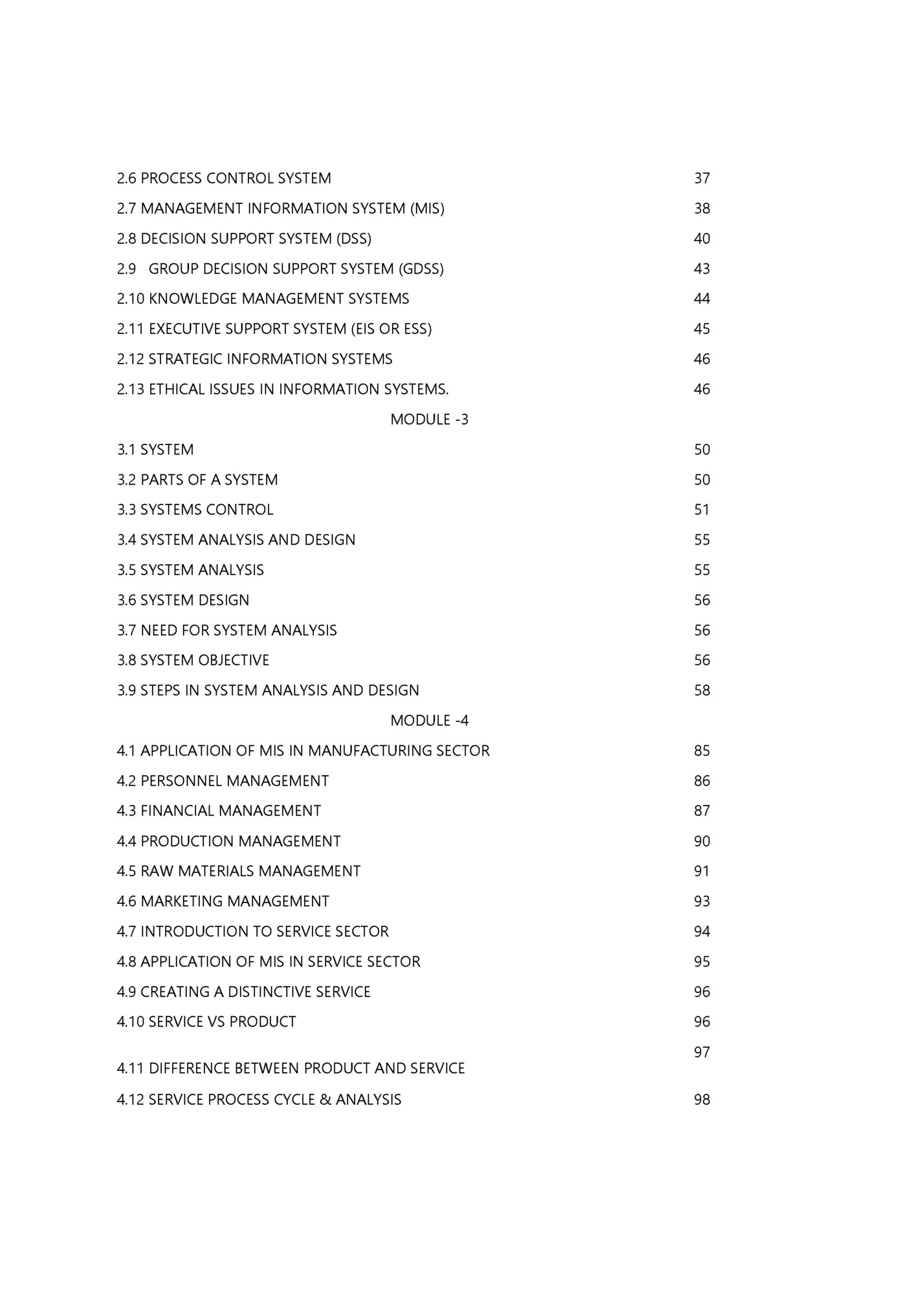
99 4.14 MIS APPLICATIONS IN HOTEL 100 4.15 MIS APPLICATIONS IN HOSPITAL 107 4.16 MIS APPLICATIONS IN BANKING 116 4.17 MIS APPLICATIONS IN INSURANCE 119 MODULE -5 5.1 INFORMATION TECHNOLOGY INFRASTRUCTURE 125 5.2 DATA PROCESSING 126 5.3 TRANSACTION PROCESSING 127 5.4 APPLICATION PROCESSING 128 5.5 INFORMATION SYSTEM PROCESSING 129 5.6 TQM OF IS 131 5.7 INTRODUCTION NETWORK 135 5.8 TYPES OF NETWORKS 136 5.9 NETWORK TOPOLOGY 138 5.10 DATA COMMUNICATION 139 5.11 DATA & CLINT SERVICE ARCHITECTURE RDBMS 139 5.12 DATA WARE HOUSE 140 5.13 INTRODUCTION TO E-BUSINESS 142 5.14 MODELS OF E-BUSINESS 145 5.15 INTERNET AND WORLD WIDE WEB (WWW), 149 5.16 INTRANET AND EXTRANET 149 5.17 SECURITY IN E-BUSINESS 150 5.18 ELECTRONIC PAYMENT SYSTEM 152 5.19 IMPACT OF WEB ON STRATEGIC MANAGEMENT 154 5.20 WEB ENABLED BUSINESS MANAGEMENT 155 5.21 MIS IN WEB ENVIRONMENT. 157 6.1 EMERGING EXPONENTIAL TECHNOLOGIES IN BUSINESS DECISION MAKING 159 6.2 INTRODUCTION TO EMERGING TECHNOLOGIES 159 6.3 TYPES OF EMERGING TECHNOLOGIES 160 6.4 INTRODUCTION TO AI 162 6.5 HISTORY OF AI 163
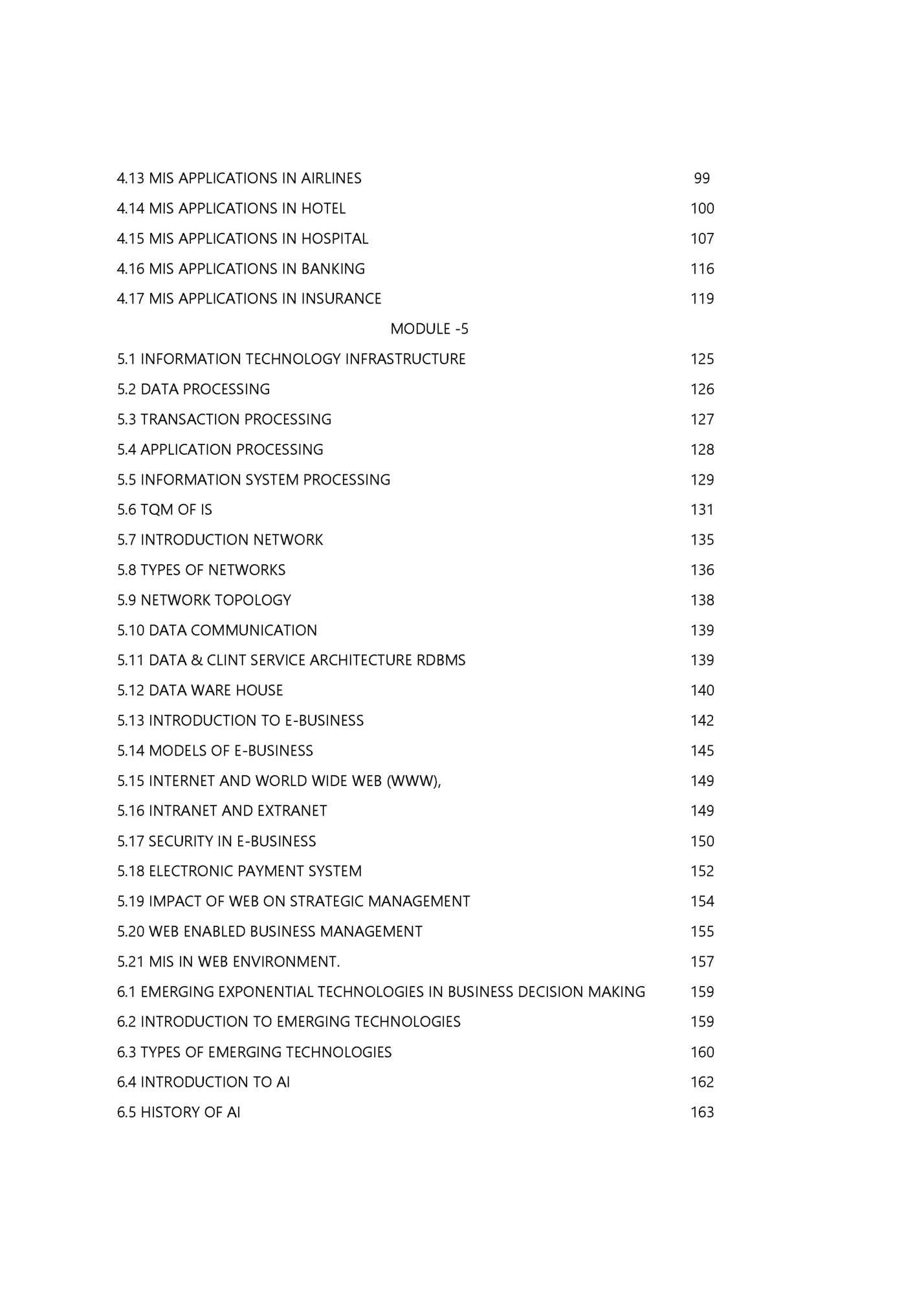
164 6.7 APPLICATIONS OF AI IN AGRICULTURE 164 6.8 APPLICATIONS OF AI IN HEALTH 168 6.9 APPLICATIONS OF AI IN BUSINESS 174 6.9 APPLICATIONS OF AI IN BUSINESS 179 6.10 APPLICATIONS OF AI IN EDUCATION 179 6.11 INTRODUCTION TO IOT 182 6.12 APPLICATIONS IOT AT SMART HOME 185 6.13 APPLICATIONS IOT AT SMART GRID 186 6.14 APPLICATIONS IOT AT SMART CITY 189 6.15 APPLICATIONS IOT AT WEARABLE DEVICES 191 6.16 APPLICATIONS IOT AT SMART FARMING 192 6.17 INTRODUCTION TO AR, VR AND MR 194 6.18 APPLICATION OF AR SYSTEMS IN EDUCATION 203 6.19 AR IN ENTERTAINMENT 207
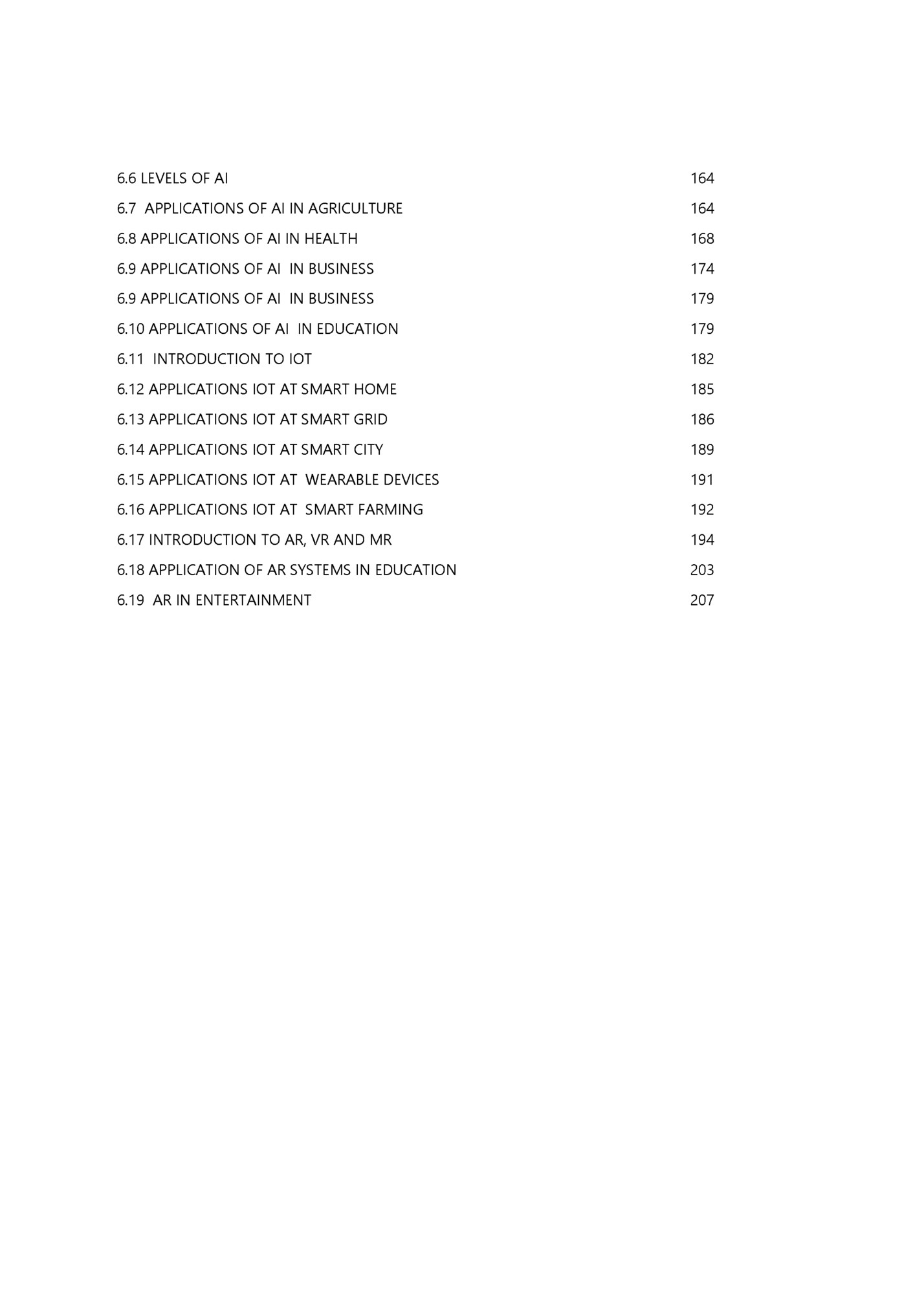
Information Technology for Managers (22MBA302) Syllabus Module-1 Introduction to MIS: Concepts, Roles, Impacts, MIS & its users, Components of an IS, Management as Control systems, MIS support to Organization Effectiveness, MIS for Ebusiness Digital Firms – E-Commerce, E – Communication, E-Collaborations, Real Time Enterprise, MIS: Strategic Business Planning, concept of Corporate planning, Essentiality of strategic Planning, Balance Score card, Score Card & Dash Board, Security Challenges in E- Enterprises, Impacts of Information Technology on society. Module-2 Kinds of Information Systems: Transaction Processing System (TPS) - Office Automation System (OAS) - Management Information System (MIS) - Decision Support System (DSS) and Group Decision Support System (GDSS) - Expert System (ES) - Executive Support System (EIS or ESS), Ethical Issues in Information systems. Module-3 System Analysis and Development and its models: Need for System Analysis - Stages in System Analysis - Structured SAD and tools like DFD, Context Diagram Decision Table and Structured Diagram. System Development Models: Water Flow, Prototype, Spiral, RAD – Roles and responsibilities of System Analyst, Database Administrator and Database Designer. Module-4 Application of MIS in Manufacturing and Service Sector: Introduction- Personnel Management, Financial Management, Production Management, Raw Materials Management, Marketing Management. Introduction to Service Sector, Creating a distinctive service, MIS Applications in Airlines, Hotel, Hospital, Banking, Insurance Department of Management Studies, JNNCE,Shimoga Page 1
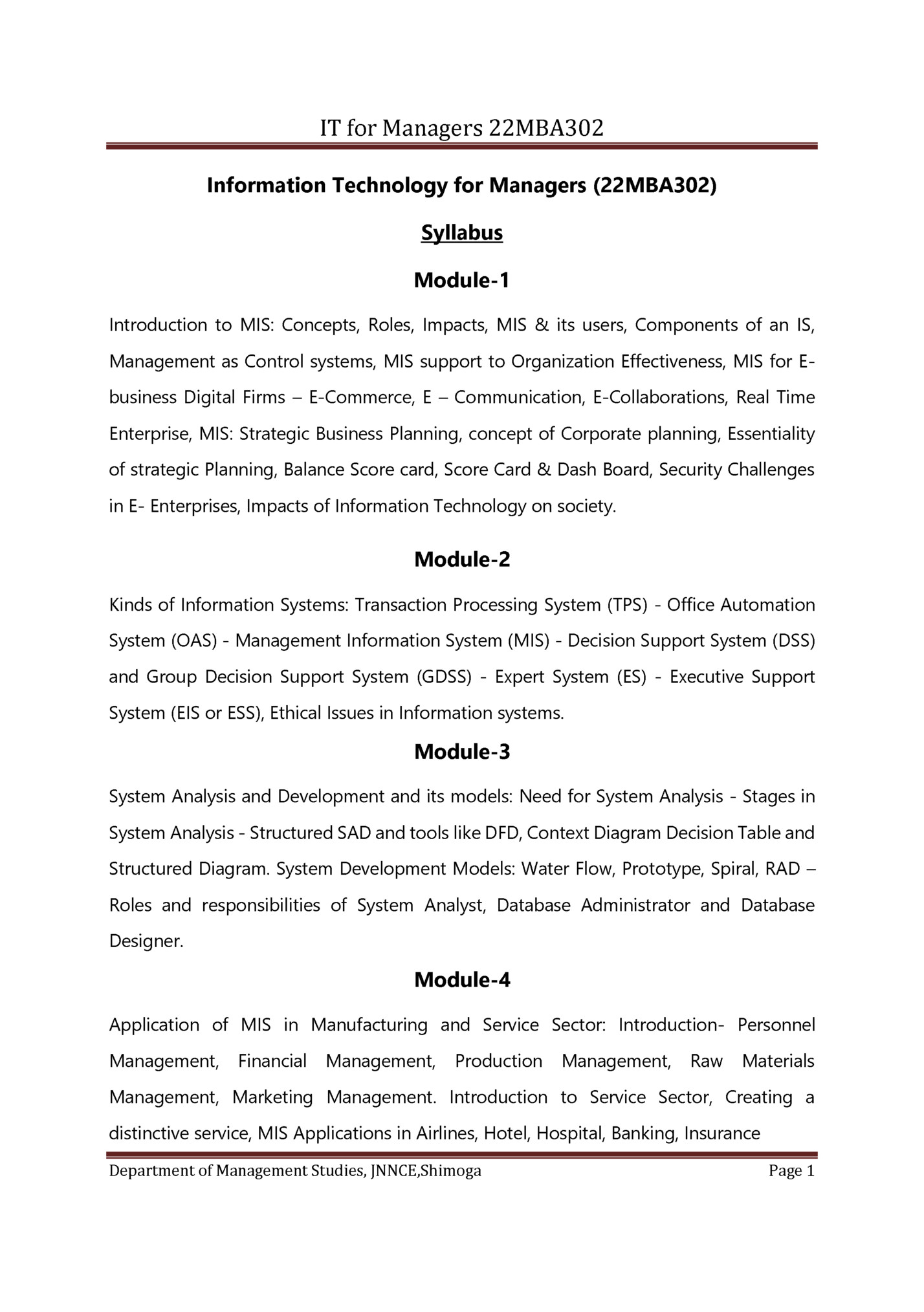
Module-5 Information Technology Infrastructure: Introduction, data processing, transaction processing, application Processing ,information system processing, TQM of IS, introduction network, network topology, data communication, Data & Clint Service Architecture RDBMS, Data Ware House, Introduction to E-business, models of E-business, internet and World Wide Web (WWW), Intranet and extranet, Security in E-business, electronic payment system, Impact of web on strategic management, web enabled business management, MIS in web environment. Module-6 Emerging Exponential Technologies in Business Decision Making. Introduction to Emerging Technologies and its types. Introduction to AI and its Applications in Agriculture, Health, Business, Education. Introduction to IOT and its Applications at Smart home; Smart grid; Smart city; Wearable devices; Smart farming. Introduction to AR, VR and MR, Application of AR systems (education, medical, entertainment). Department of Management Studies, JNNCE,Shimoga Page 2
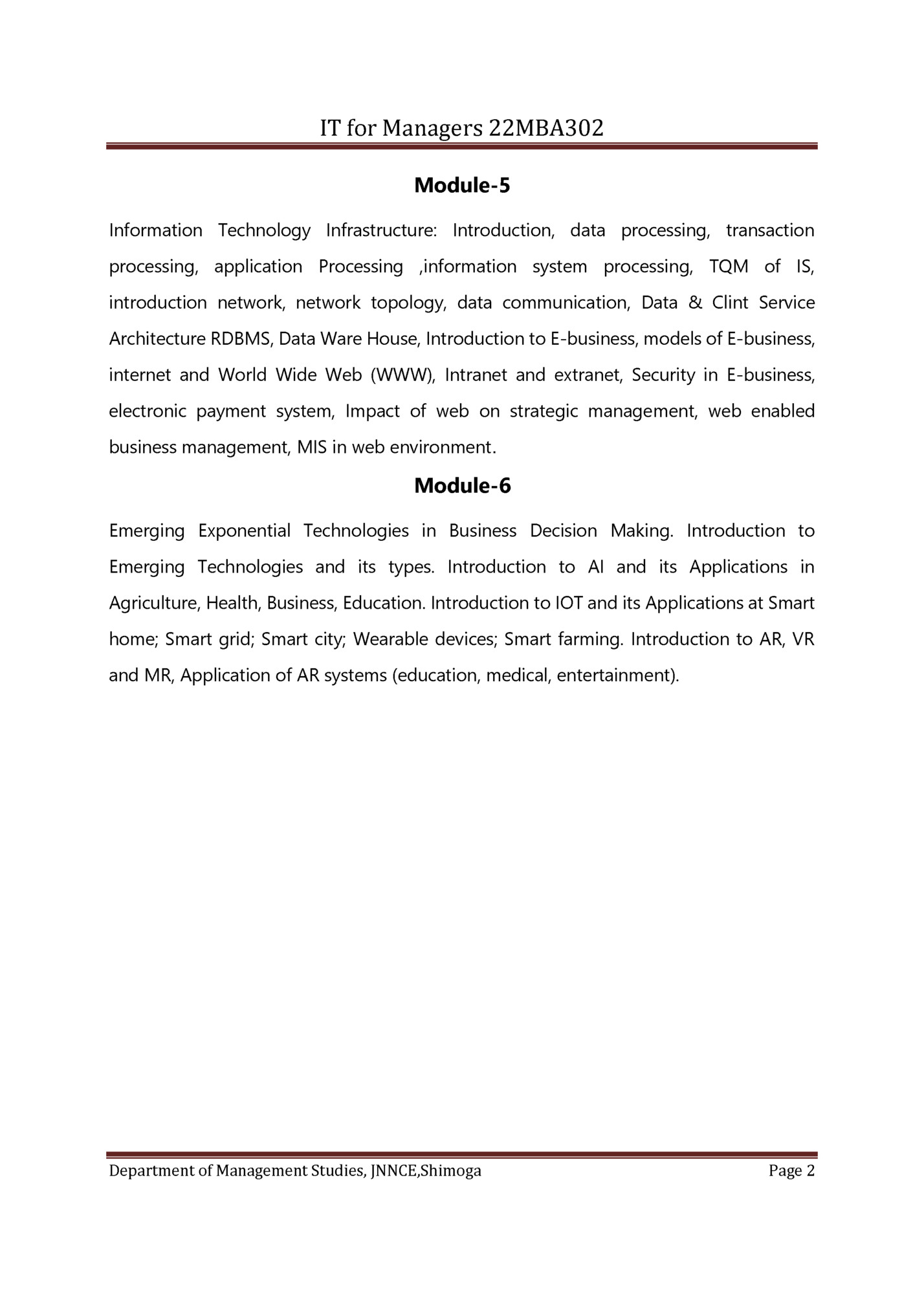
Module-1 1.1 Introduction to Management Information System (MIS) A management information system (MIS) is a computer-based system that provides information and data to support the decision-making process of an organization's management. It collects, processes, stores, and distributes information in a timely and efficient manner, allowing managers to make informed decisions. The purpose of an MIS is to help managers at all levels of an organization to plan, organize, and control operations, and make strategic decisions. MIS includes software applications, hardware, and people. It collects data from various sources and then processes and summarizes the data into meaningful reports and dashboards that can be used to identify trends, monitor performance, and make informed decisions. Fig 1.1 Components of MIS Department of Management Studies, JNNCE,Shimoga Page 3

A management information system (MIS) is a computer-based system that provides information and data to support the decision-making process of an organization's management. Definition of Management According to Harold Koontz, “Management is an art of getting things done through and with the people in formally organized groups.” Definition of Information Information is the data that has processed in to a form that is meaning full the recipient. Fig. 1.2 Data to Information Process Fig. 1.3 Data and Information Department of Management Studies, JNNCE,Shimoga Page 4
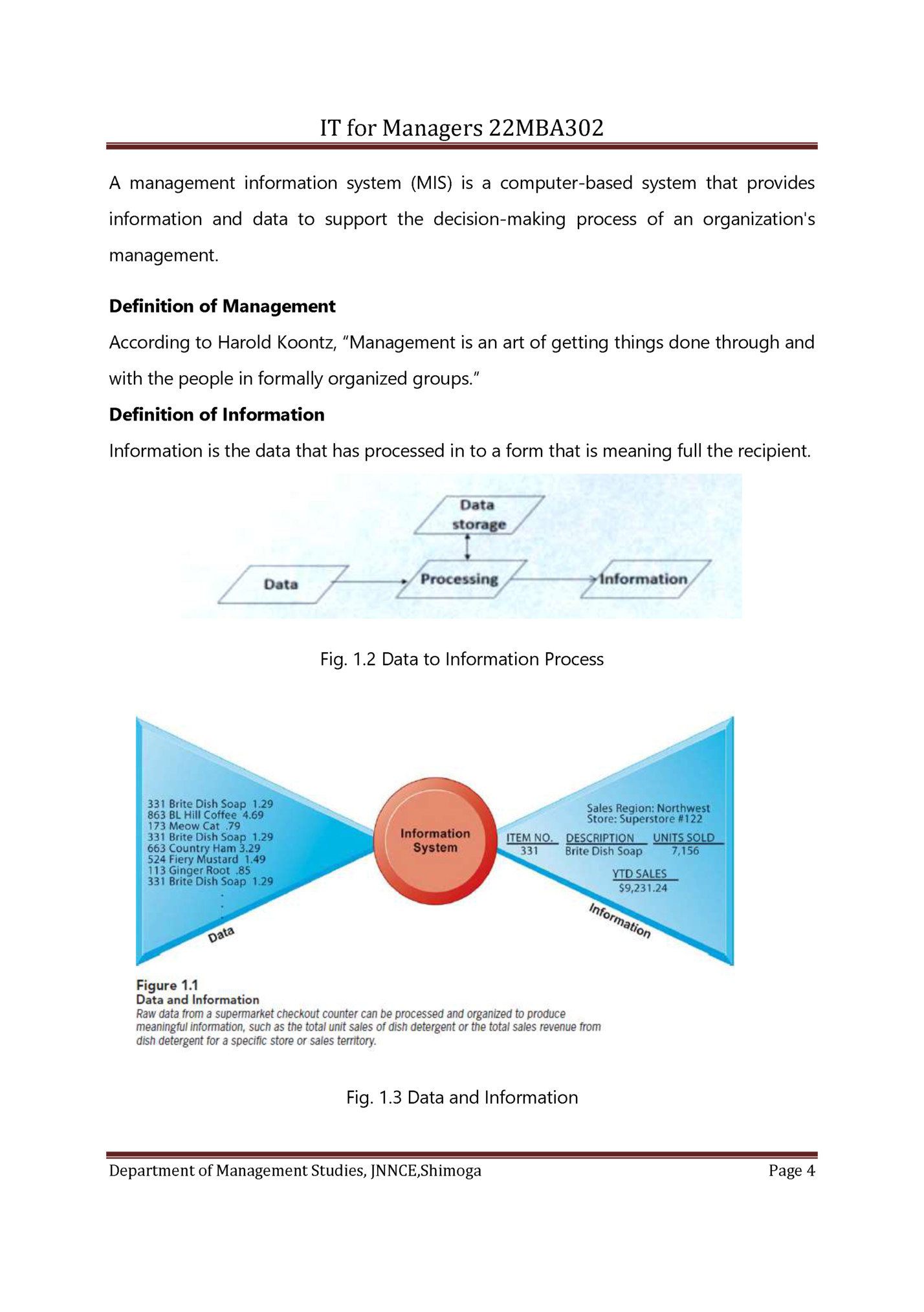
Fleepit Digital © 2021